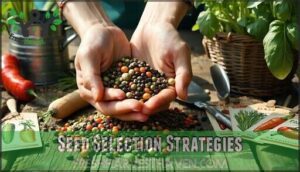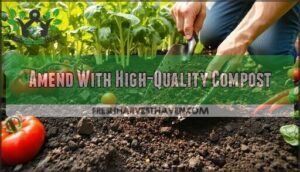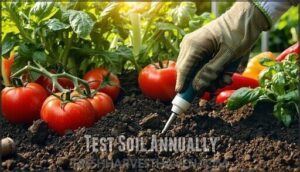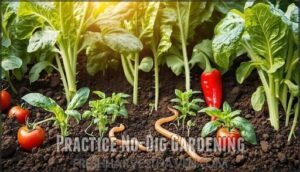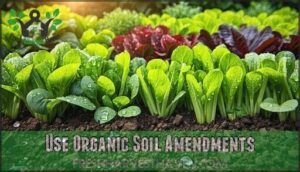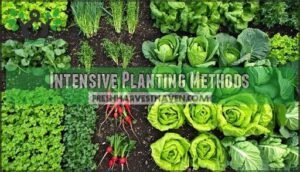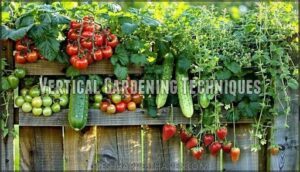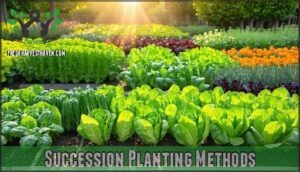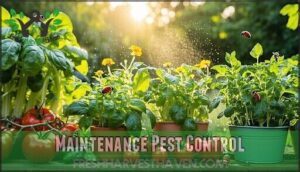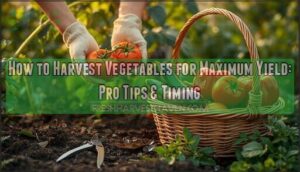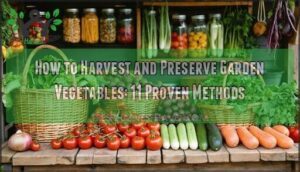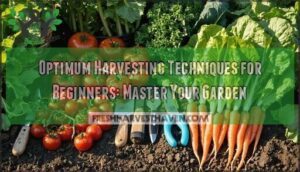This site is supported by our readers. We may earn a commission, at no cost to you, if you purchase through links.
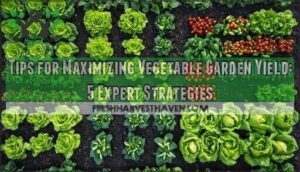
Use intensive planting methods like square-foot gardening and go vertical with trellises to double your growing space.
Plant fast-maturing crops in succession every 2-3 weeks for continuous harvests.
Companion planting boosts production—think tomatoes with basil or corn with beans, and apply mulch to retain moisture and suppress weeds.
While consistent watering and organic fertilization keep plants thriving, smart planning and record-keeping help you replicate successes and avoid past mistakes.
These foundational strategies set the stage for transforming any garden into a high-yield powerhouse.
Table Of Contents
- Key Takeaways
- Seed Selection Strategies
- Soil Health Preparation
- Planting Techniques Optimization
- Maintenance Pest Control
- Garden Planning Recordkeeping
- Frequently Asked Questions (FAQs)
- How do I increase my garden yield?
- How to maximize your vegetable garden space & harvest?
- How to increase yield in an edible garden?
- How can I improve soil quality for a bigger garden yield?
- How can I maximize my vegetable garden?
- How can garden design increase yield?
- How much sunlight do vegetables really need?
- Can I grow vegetables in containers?
- When is the best time to fertilize?
- How do I prevent common garden pests?
- Conclusion
Key Takeaways
- Choose high-yielding hybrid varieties and test seed viability before planting – you’ll get 20-25% higher harvests with disease-resistant hybrids that deliver consistent results.
- Build nutrient-rich soil with 2-3 inches of quality compost and practice no-dig gardening to maintain soil structure while feeding beneficial microorganisms naturally.
- Maximize your growing space through vertical trellises, square-foot gardening, and succession planting every 2-3 weeks for continuous harvests from the same area.
- Keep detailed records of what works and what doesn’t – document planting dates, varieties, pest issues, and weather patterns to make data-driven decisions that boost future yields.
Seed Selection Strategies
Your seed choices directly impact your garden’s productivity before you even plant.
Start with varieties labeled ‘high-yielding‘ or ‘prolific,’ and always test seed viability by placing a few on damp paper towels—seeds that don’t sprout within their expected timeframe won’t perform well in your garden either.
Choose Hybrid Varieties
Hybrid varieties pack a punch when you’re aiming to maximize garden yield.
These genetic powerhouses deliver 20-25% higher harvests than heirloom types through hybrid vigor. You’ll get disease resistance, yield consistency, and genetic stability that translates to better returns.
One significant advantage is their ability to provide superior disease resistance, minimizing plant loss.
While you can’t save seeds for next season, the improved performance makes hybrid varieties worth every penny for serious vegetable gardening success.
Check Seed Viability
After selecting hybrid varieties, you’ll want to test your seeds before planting season arrives. Old or improperly stored seeds can devastate your vegetable garden yield, turning your high yield gardening dreams into disappointment.
Here’s how to maximize garden success through proper Seed Age and Storage Conditions assessment:
- Perform simple Germination Testing – Place 10 seeds on damp paper towels in a sealed container for 7-10 days
- Check packaging dates – Most Seed Companies print harvest years, with 2-3 year-old seeds showing declining Viability Factors
- Examine physical condition – Wrinkled, discolored, or cracked seeds rarely produce strong plants
- Consider storage history – Seeds exposed to heat, moisture, or freezing conditions lose viability quickly
Opt for Fast-Maturing Varieties
Speed becomes your ally when selecting fast-maturing varieties for quick harvests and early yields.
Radishes deliver results in just four weeks, while fast-growing vegetables like lettuce provide continuous cuts throughout the short season.
These high-yielding vegetables maximize your garden’s potential through rapid growth cycles.
Timely planting of these varieties guarantees multiple harvests per season, dramatically boosting your vegetable garden yield from the same space.
Regionally Appropriate Varieties
Climate considerations trump everything when choosing plant varieties.
Your growing zone determines which vegetables thrive naturally in your area’s temperature ranges and frost dates.
Local nurseries stock regionally appropriate varieties proven to succeed in your specific conditions.
Microclimates matter too—your backyard’s unique sun, wind, and moisture patterns affect plant performance.
Regional gardening wisdom suggests selecting high yield plants with built-in pest resistance for your climate zone.
Soil Health Preparation
Your soil’s health determines your garden’s success, so you’ll want to start with a solid foundation before planting anything.
Building nutrient-rich, well-structured soil through proper amendments and testing creates the ideal environment for maximum vegetable production.
Amend With High-Quality Compost
Rich compost transforms ordinary garden soil into a nutrient powerhouse that feeds your plants all season long.
Transform your garden soil into a living, breathing ecosystem that naturally feeds your plants with premium compost.
Quality compost delivers essential nutrients while introducing beneficial microbes that create thriving soil ecosystems.
Consider using high-quality options for best results.
Here are four key compost application strategies:
- Layer 2-3 inches of finished compost around established plants, keeping it away from stems to prevent rot and disease issues.
- Mix compost directly into planting holes at a 1:1 ratio with existing soil for new transplants and seedlings.
- Choose diverse compost types like leaf mold, kitchen scraps, and aged manure to maximize nutrient variety and soil benefits.
- Apply compost twice yearly – once in spring before planting and again in fall to maintain soil health throughout growing seasons.
Test Soil Annually
Annual soil testing reveals your garden’s hidden needs.
Most vegetable gardens demand testing every year due to heavy nutrient demands.
Testing prevents costly over-fertilization while catching nutrient deficiency signs early.
Local extension services often provide affordable testing options.
Knowing your soil’s nutrient and pH levels is vital for healthy growth.
| Testing Method | Benefits |
|---|---|
| Professional Lab Tests | Detailed nutrient analysis, pH level impact assessment |
| DIY Soil Tests | Quick results, cost-effective for basic needs |
| Extension Service Testing | Expert interpretation, regionally-specific recommendations |
| Multi-zone Sampling | Accurate garden soil health overview across different areas |
Regular testing transforms guesswork into precision, ensuring your soil nourishment supports maximum yields.
Practice No-Dig Gardening
Transforming your garden into a no-till paradise keeps soil structure intact and thriving.
This minimal disturbance approach protects the delicate soil food web while maximizing garden yield optimization through natural processes.
- Layer organic matter directly on soil surface without digging
- Add compost layers annually to feed beneficial microorganisms naturally
- Suppress weeds effectively using cardboard and mulch combinations
- Improve water retention as undisturbed soil holds moisture better
- Build nutrient-rich soil through decomposition without disrupting organisms
Use Organic Soil Amendments
Beyond building healthy soil through no-dig methods, you’ll want to supercharge your garden with organic amendments.
Compost tea delivers nutrients directly to plant roots, while green manure and cover cropping add nitrogen naturally.
Biochar benefits include improved water retention and microbial activity.
Worm castings provide slow-release nutrition for nutrient-rich soil throughout the growing season, and overall, these methods help create a thriving garden with improved water retention.
Planting Techniques Optimization
Once you’ve prepared your soil, smart planting techniques can dramatically boost your harvest without expanding your garden space.
These methods focus on maximizing every square foot through strategic plant placement and timing.
Intensive Planting Methods
Once you’ve built healthy soil, focus on maximizing every square inch through smart plant spacing.
The French Intensive Method uses close spacing with deep soil preparation. Square Foot Gardening divides beds into one-foot sections, fitting up to sixteen radishes or one cabbage per square.
These biointensive approaches increase yields dramatically compared to traditional row planting, utilizing methods like Square Foot Gardening and the French Intensive Method.
Vertical Gardening Techniques
With vertical gardening, you’ll transform unused space into productive growing areas.
Cucumbers, peas, beans, and tomatoes thrive when climbing upward, creating better air circulation and easier harvests.
Consider trellis system options for ideal growth.
- Trellis Selection: Choose sturdy structures for heavy vining vegetables like squash
- Hanging Baskets: Perfect for trailing crops and space maximization in small gardens
- Wall Planters: Mount against fences for climbing vegetables and high yield plants
- Plant Support: Install before planting to avoid root damage later
- Vertical Layout: Position trellises on north side to prevent shading ground crops
Companion Planting Strategies
You’ll maximize space while improving plant health through strategic companion planting.
Pair tomatoes with basil for natural pest deterrents and enhanced flavor.
Plant carrots alongside onions to optimize space and repel harmful insects.
These beneficial partnerships create natural pest barriers while supporting nutrient cycling.
Smart garden plant compatibility choices boost crop diversity and attract beneficial insects for better pollination.
Succession Planting Methods
Staggered planting keeps your harvest flowing like a steady stream.
Smart timing brings continuous bounty to your table.
Plant new lettuce every two weeks for continuous harvest, then follow with succession crops like tomatoes after early greens finish.
Your garden planner becomes your best friend for tracking these overlapping schedules.
Crop rotation naturally follows as you cycle through different plant families, maximizing space while maintaining soil health through strategic intercropping benefits.
Optimize planting intervals by tracking days to maturity for each crop, ensuring a continuous harvest and allowing for succession crops to be planned effectively, which aids in crop rotation.
Maintenance Pest Control
Once you’ve established your garden layout and planting schedule, consistent maintenance becomes your secret weapon for bumper harvests.
Smart pest control, proper fertilization, and water management can double your yield while keeping your plants healthy through the growing season, utilizing smart pest control.
Regular Fertilization
Your plants crave consistent nutrition to produce maximum yields.
Think of fertilizing like feeding a growing teenager – they need regular, balanced meals to thrive.
Soil testing reveals exactly what nutrients your garden lacks, letting you choose the right fertilizer types for ideal plant nutrition.
- Feed every 2-3 weeks during growing season with organic fertilizers or balanced synthetic options
- Test soil annually to adjust nutrient management strategies and maintain proper nutrient balance
- Choose organic options like compost, fish emulsion, or kelp meal for sustained, nutrient-rich soil health
Natural Pest Control Methods
Beyond keeping your plants well-fed, you’ll need smart pest control methods that won’t harm your harvest.
Beneficial insects like ladybugs naturally control aphids, while companion planting with marigolds deters bean beetles.
Physical barriers and homemade sprays offer chemical-free garden pest prevention that keeps your vegetables safe.
| Natural Method | Target Pests |
|---|---|
| Row covers | Flying insects, beetles |
| Essential oil sprays | Aphids, soft-bodied pests |
| Beneficial insects | Various garden pests |
Mulch Application Benefits
Mulching acts like a protective blanket for your garden soil.
Apply 2-3 inches of organic matter such as straw, wood chips, or shredded leaves around plants.
This layer provides soil moisture retention, weed suppression, and temperature regulation while preventing erosion control.
As mulch decomposes, it enhances garden soil improvement and supports garden nutrient management naturally.
Rainwater Irrigation Systems
Transform your garden’s water game with rainwater harvesting systems that slash irrigation costs by up to 50%.
System installation captures chemical-free water through rooftop collection, storing it in tanks with proper filtration methods.
This water management approach boosts garden water efficiency while your plants thrive on natural H2O.
Using neem oil solutions can also protect your plants from pests.
Smart watering techniques plus rainwater irrigation equals serious cost savings and superior garden water conservation, making it a great way to improve your garden’s water efficiency.
Garden Planning Recordkeeping
You’ll achieve better harvests by documenting what works and what doesn’t in your garden each season.
Smart recordkeeping helps you repeat successes, avoid past mistakes, and make data-driven decisions that boost your yields year after year.
Create Physical Garden Plans
Drawing an accurate garden layout keeps your plants happy and productive. Sunlight mapping helps you identify which areas get morning versus afternoon sun. This spatial arrangement prevents overcrowding and maximizes your growing space.
- Sketch your garden dimensions – Measure and draw your plot to scale, marking existing features like trees or structures that affect sunlight patterns.
- Map sun exposure zones – Track which areas receive full sun (6+ hours), partial sun (3-6 hours), or shade throughout the day using garden planning tools.
- Plan crop placement strategically – Position tall plants on the north side to avoid shading shorter ones, and group plants with similar spacing requirements together for efficient garden planning strategies.
Keep Gardening Journals
Your garden journal becomes your personal roadmap to success.
Record planting dates, varieties, and locations for effective crop rotation planning.
Document pest outbreaks and weather patterns that affect your harvest.
Note which techniques boost garden productivity and yields.
This journaling benefits your garden optimization by revealing patterns you’d otherwise miss, helping you refine your garden planning for maximum harvest techniques.
Track Successes and Failures
Documenting your garden’s wins and losses creates a roadmap for Data-Driven Gardening success.
Record which varieties delivered exceptional garden yield versus those that disappointed.
Note specific harvest techniques that boosted production and environmental factors that influenced outcomes.
This Pattern Recognition approach transforms random gardening into strategic garden optimization.
Your failure analysis becomes tomorrow’s Iterative Improvement plan, turning setbacks into high-yield gardening victories through systematic garden strategies.
Remember to also amend soil yearly for best results, leading to strategic garden optimization.
Adjust Plans for Logistical Issues
Flexibility beats perfectionism when unexpected events derail your garden strategies.
Weather setbacks, pest resurgence, equipment malfunctions, and time constraints will test your resolve.
Smart gardeners pivot their plans rather than abandon them entirely, keeping backup seed varieties ready, alternative planting dates mapped out, and flexible harvest management systems.
When life throws curveballs, adaptable garden productivity still delivers high-yield plants through strategic adjustments.
Frequently Asked Questions (FAQs)
How do I increase my garden yield?
Like a master chef combining ingredients, you’ll maximize garden yield by planting high-producers like tomatoes and zucchini.
Growing vertically with trellises, interplanting fast crops between slower ones, and succession planting for continuous harvests.
How to maximize your vegetable garden space & harvest?
You’ll double your harvest by using vertical trellises for climbing crops.
Interplanting fast-growing radishes between slower vegetables is another method to increase yield.
Succession planting every few weeks and choosing high-yield varieties like zucchini and cherry tomatoes are also effective strategies.
How to increase yield in an edible garden?
Choose high-yield varieties, use vertical trellises for climbing plants, practice succession planting for continuous harvests, interplant quick crops with slower ones, and add compost regularly to maintain soil fertility.
How can I improve soil quality for a bigger garden yield?
Add compost or aged manure to enrich nutrients.
Test soil pH and adjust to 0-0 for ideal nutrient uptake.
Incorporate organic matter like leaf mold to improve structure and water retention.
How can I maximize my vegetable garden?
Radishes mature in just 4-6 weeks, proving quick wins matter.
Maximize your garden by selecting high-yielding varieties, using vertical space for climbing plants, interplanting fast and slow crops together, and practicing succession planting for continuous harvests throughout the season.
How can garden design increase yield?
Use vertical growing with trellises for climbing plants like beans and cucumbers.
Practice succession planting—harvest quick crops, then immediately plant new ones.
Interplant fast-growing radishes between slower vegetables to maximize space efficiency.
How much sunlight do vegetables really need?
Like plants reaching for the sun, your vegetables crave those golden rays.
Most need 6-8 hours of direct sunlight daily for peak production, though leafy greens can tolerate partial shade surprisingly well.
Can I grow vegetables in containers?
Yes, you can successfully grow vegetables in containers.
Choose pots at least 12 inches deep with drainage holes.
Most vegetables thrive in containers, including tomatoes, peppers, lettuce, herbs, and compact varieties of squash and beans, which are all great options to consider for container gardening.
When is the best time to fertilize?
Fertilize when plants start actively growing in spring, then every 4-6 weeks during the growing season. Stop fertilizing 6-8 weeks before your first expected frost to avoid tender growth.
How do I prevent common garden pests?
While bugs can devastate crops, smart gardeners fight back with companion planting, beneficial insects, and organic sprays.
Plant marigolds, basil, and nasturtiums to repel pests naturally.
Encourage ladybugs and birds for biological control.
Conclusion
Maximizing yield requires commitment, consistency, and careful attention to detail.
By selecting the right seeds, preparing nutrient-rich soil, and using smart planting techniques, you’ll transform your garden into a productive space.
Regular maintenance through proper fertilization, pest control, and mulching keeps plants healthy throughout the growing season.
Most importantly, documenting your experiences helps refine these tips for maximizing vegetable garden yield year after year, ensuring continuous improvement and abundant harvests.
- https://gardenseason.com/high-yielding-vegetable-garden/
- https://www.gardeningknowhow.com/edible/vegetables/vgen/increase-garden-yield.htm
- https://thetreetrove.com/how-and-when-to-plant-vegetable-garden/
- https://plantisima.com/simple-tips-for-growing-the-perfect-vegetable-garden/
- https://homegardenliveadviceinc.com/best-vegetable-gardening-techniques/

